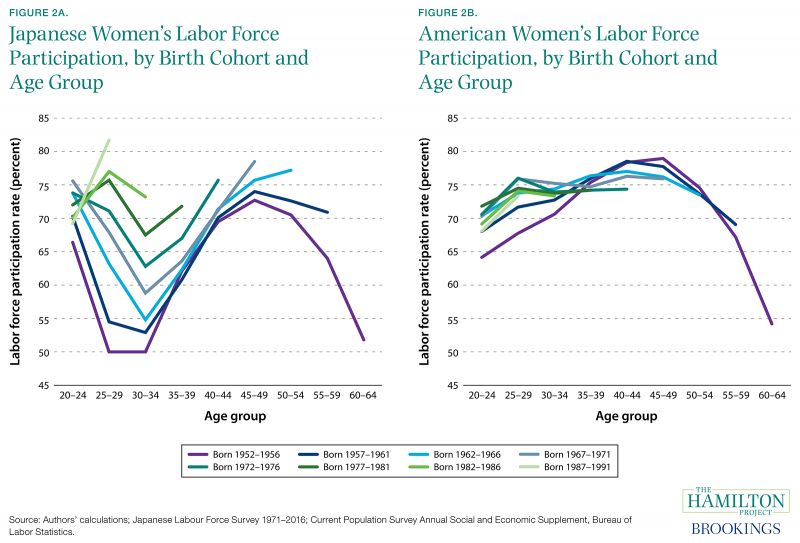After decades of steady gains, U.S. women’s labor force participation peaked in 2000. In retrospect, this was an important turning point: rising women’s participation had fueled household income and economic growth, and helped offset declining prime-age male labor force participation. Declining prime-age women’s participation since then has weakened growth, exacerbating the labor force participation decline stemming from an aging population. With fewer workers contributing to the economy, economic growth and improvement in living standards have been weaker than they otherwise would have been.
Understanding the U.S. decline in prime-age women’s participation is therefore an urgent concern. In this economic analysis, we seek to learn from a labor market that has been on an entirely different trajectory from that of the United States, and a country that has made women’s labor force participation a top macroeconomic priority. After lagging behind U.S. women for more than forty years, Japanese prime-age women have now caught up and exceeded the U.S. rate of labor force participation (defined as the fraction of the population either working or searching for work).1 In 2000, Japan’s prime-age female labor force participation rate was just 66.5 percent, below the OECD average and a full 10 percentage points below the U.S. level. Since that time, the U.S. rate trended down to 74.3 percent in 2016 while the Japanese rate has risen to 76.3 percent (figure 1). We analyze some of the potential determinants of this shift, including demographic, economic, and policy factors.

At the same time, Japanese women’s labor market outcomes are often less favorable than those of American women, despite the higher rate of labor force participation in Japan. The economic developments and policies that contribute to greater participation are not always identical to those that improve women’s economic outcomes more generally. Far more Japanese women work in part-time or non-regular jobs and the increase in labor force participation has been accompanied by an increase in the share of women working part-time or in non-regular jobs. For policy makers, women’s labor force participation and the quality of women’s labor market opportunities are dual objectives, both important for economic growth.
Holding constant the quality of women’s jobs, the economic impact of changes in women’s labor force participation is potentially very large. If U.S. prime-age women had gained as much ground from 2000 to 2016 as their Japanese counterparts, one simple calculation suggests that GDP in the United States would have been around $800 billion (over 4%) higher in 2016 than it actually was, increasing GDP per person by nearly $2,500.2 To the extent that well-designed policies can remove impediments to women’s labor force participation, they will yield important benefits for the economy as a whole.
As the United States grapples with how to increase growth and labor force participation, lessons from Japan’s surge in participation—as well as Japan’s relatively poor outcomes for employed women—are particularly pertinent. We broadly consider three types of explanations for the increase in Japanese women’s participation: those based on the demographic composition of prime-age women; those based on the economic incentives to work; and those based on policy developments that encourage women’s labor force participation. We find that aging and growing levels of educational attainment were not at the root of Japan’s post-2000 prime-age participation increase and that the declining share of married women played a small role. Japan’s public policies have become steadily more supportive of women’s labor market engagement, though it is difficult to trace a clear link between these reforms and rising participation.
Women’s participation trends have been very different in the United States and Japan
The differing experiences of women in the Japanese and U.S. labor markets—and the starkly different ways in which they have changed over time—provide a useful opportunity to better understand the challenges facing women and policy makers in the United States. One way to compare the participation rates of women in the two countries is look at successive cohorts and plot their participation rates by age. As we show in figure 2, younger women in Japan have interacted with the labor market very differently than younger women in the United States.

Japan’s labor market was once notable for the pronounced “M-shaped” pattern of women’s labor force participation. High participation just after degree attainment was followed by a decline during marriage and early childrearing years, eventually giving way to a rebound in labor force participation (figure 2a). For example, 66 percent of women born between 1952 and 1956 participated in the labor force in their early 20s, but half of those women participated in their late 20s and early 30s. By their 40s, that participation rate had risen past its original level to roughly 70 percent. Such an M-shaped pattern is absent or greatly attenuated in the United States (figure 2b). In prior decades, U.S. women in their late 20s and 30s participated in the labor market far more than their counterparts in Japan, and there was a slow rise in participation as women aged from their 20s to their mid-40s.
Subsequent cohorts of women in Japan have increasingly broken from this pattern. Every cohort born after the 1952–56 group has experienced a successively smaller—and somewhat delayed—early-career decline in labor force participation. Indeed, women born after 1977 have maintained or increased their participation through their 20s, with relatively muted declines in the early 30s. In contrast, women born in the 1980s in the United States do not participate at higher rates than previous cohorts, and in fact are slightly less likely to be in the labor force.
What demographic factors could account for the increase in Japanese women’s participation?
The simultaneous decline in U.S. women’s participation and rise in Japanese women’s participation that began around 2000 is particularly striking. In that year, prime-age women in Japan participated at a rate fully 10.2 percentage points below that of their U.S. counterparts; by 2016, Japanese women participated at a 2.0 percentage point higher rate. Perhaps surprisingly, standard demographic factors like aging and educational attainment appear to play very limited roles in accounting for these trends.
Aging
The first explanation we consider is population aging. Even though our focus is on prime-age workers, differences in participation rates within that group imply that aging could have affected overall prime-age participation.3 In figure 3, the percent change between 2000 and 2016 in the number of Japanese and U.S. women is shown for five-year age groups. While both the Japanese and U.S. populations have aged considerably, and although the Japanese population is older and has aged faster since 2000, the average age of the prime-age group has not shifted notably in either country.

Consequently, aging during the 2000–16 period had little effect on either Japanese or U.S. prime-age women’s participation.4 Because the M-shaped pattern was historically more pronounced for Japanese than for U.S. women, the shift towards a higher fraction of middle-aged people would plausibly have lifted prime-age participation considerably more in Japan than in the United States. However, the contributions of aging from 2000 to 2016 were negligible in both countries, raising the prime-age participation rate by 0.1 percentage points in Japan and reducing it by 0.1 percentage points the United States.5
Educational Attainment
As in the United States, educational attainment of women in Japan has risen. Because people with more education are more likely to be in the labor force, this growth in attainment can account for some of the rise in labor force participation. Figure 4 shows both the change in educational attainment and the pattern of labor force participation by education for the two countries.

However, only 0.2 percentage points of the increase in prime-age Japanese women’s participation can be ascribed to shifts in educational attainment, despite their 11 percentage point increase in attainment of four-year degrees from 2000 to 2016. Unlike in the United States, labor force participation simply does not vary enough across education groups in Japan for increasing educational attainment to have meaningfully shifted prime-age participation.6 The similar pattern of participation for Japanese women with various educational backgrounds— both in terms of rates and changes over time—stands in stark contrast to the widening gap of participation rates across educational attainment for American women (shown in Figure 4b).
Because labor force participation is more strongly associated with education in the United States, the 2000–16 increase in educational attainment would have been expected to lead to a 1.4 percentage point increase in participation. This stands in contrast to the decline that actually occurred over that period, suggesting that an increase in education was helping offset other factors in the United States. Not only do education shifts not explain Japan’s relative rise in participation, but after adjusting for educational attainment shifts, the gap between the U.S. and Japan is even larger.
Marriage and Birth Patterns
Women’s labor market opportunities and choices are often intertwined with marriage and children. Particularly in Japan, earlier cohorts of women typically left the labor force during their 20s and 30s, re-entering only after their children had grown older.7 Consequently, we examine the potential role of changing marital and childbirth patterns in explaining participation trends for Japan and the United States.

In both countries, the age at first marriage has risen steadily since the early 2000s, contributing to a decline in the share of the prime-age population that is married. With Japanese women aged 25 to 54 less likely to be married in recent years, the prime-age women’s population now contains more people who traditionally have participated in the labor market at high rates, as shown in the left panel of figure 5. Indeed, 1.7 percentage points of the increase in Japanese prime-age women’s participation can be accounted for by shifts in marital status.8 A similar calculation for the United States explains only a 0.5 percentage point increase in the U.S. participation rate.
The right panel of figure 5 shows the change—separately by marital status—from 2000 to 2016 in Japanese and U.S. prime-age women’s labor force participation. Perhaps the most important development is the rapid increase in the participation of married Japanese women: only 58 percent in 2000, it rose to 71 percent in 2016, boosting total participation. During that time, the participation rates for married American women have been trending down along with the rates for never married and divorced women.
Fewer children could also contribute to higher participation rates, but here the patterns in Japan and the U.S. suggest a relative improvement in U.S. women’s participation from 2000 to 2016—the opposite of what was observed. As shown in appendix figure 1, while the Japanese fertility rate is notably lower than in the United States, it has actually been increasing since 2005, in contrast to a U.S. fertility rate that has fallen slightly.
Labor Shortages and Stagnant Men’s Wages
Up to this point, we have considered demographic determinants of labor force participation that could potentially explain some of the diverging trends seen in Japan and the United States. We now consider two related economic explanations: labor shortages and declining men’s wages.
One hypothesis regarding increasing Japanese women’s participation is that the more advanced aging of Japan has led to a dearth of workers relative to existing capital, causing employers to raise wages and attract more individuals to the labor force. However, the post-2000 patterns of Japanese and U.S. women’s wage growth belie this explanation: annual real wage growth has been 0.3 percent and 0.4 percent for Japanese prime-age women and U.S. women, respectively. Given the absence of relatively strong Japanese wage growth, it seems unlikely that this accounts for a substantial portion of divergence in Japanese and U.S. women’s participation.
A related possibility is that declining economic opportunities for married men have induced more of their spouses to enter the labor force. Some research suggests that this effect has been significant in Japan. The substantial increase in Japanese unemployment during the 1990s caused an increase in the employment of prime-age women, with hours worked rising 4.7–6.1 hours per week for nonworking spouses of men who experienced involuntary job loss. Other research finds that married women’s participation is negatively related to their husbands’ incomes.
However, wage and unemployment trends do not suggest a large role for this explanation over the 2000–16 period. Both Japanese and U.S. men’s inflation-adjusted wages have been roughly stagnant from 2000 to 2016, and Japanese prime-age men’s unemployment rate actually fell 0.7 percentage points from 2000 to 2016.
What has the role of public policy been in shaping changes in women’s participation?
Labor force participation can respond to deliberate policy choices in addition to demographic and economic trends. For example, changes in educational investments or retirement rules can affect the labor market experiences of the youngest and oldest workers. For prime-age workers, and particularly for prime-age women, a range of workforce and child-care policies can support labor force participation.
In Japan, increased participation over time of 25 to 40-yearold women raises the possibility that changes in such policies were part of the explanation for the substantial progress. Figure 6 displays a number of relevant policy reforms, with the trends in prime-age women’s participation as a backdrop.
One example is the increase in generosity of child-care policies. In 1969, twelve weeks of paid maternity leave were guaranteed by the Japanese government; a series of reforms in 1992 and 1995 expanded this to one year of paid leave available to both parents. By 2014, Prime Minister Abe’s reforms provided for two thirds of a worker’s earnings to be replaced during the first six months of paid leave and increased government daycare capacity by 219,000 spots.9 To the extent that these initiatives help women to remain in the workforce—and in full-time, regular employment—they will facilitate better labor market outcomes for women. In particular, recent research suggests that women are considerably less likely to leave the labor force when childcare facilities are more readily available.

Japanese labor laws have also changed considerably. Until the late 1990s, the so-called women’s protection provisions put limits on women’s labor market engagement, limiting hours of work and total overtime as well as prohibiting women from working in occupations deemed dangerous. These provisions were eliminated through amendments to the Labour Standards Law that took effect in 1999. Separate reforms in the 1990s and 2000s applied anti-discrimination law more comprehensively throughout the labor market. It is also likely that the liberalization of the Worker Dispatch Law starting in 1999, which removed earlier restrictions and allowed companies in almost any industry to hire temporary workers, increased opportunities for women to join and remain in the workforce.
Some of these legal changes may also be indicative of cultural shifts. For example, World Values Survey data reveals an increasing fraction of Japanese respondents who believed that working mothers (in comparison to non-working mothers) could establish relationships with their children that were just as secure; from the early 1990s through the early 2000s, the fraction rose from 78 percent to 86 percent. Over the same period, the fraction who agreed that both husbands and wives should contribute to household income increased from 31 percent to 39 percent. These changes in attitudes likely played a key role in facilitating increased women’s participation.
The particular emphasis of this paper has been on the surprising relative progress of Japanese women starting in 2000. We do not find obvious candidates for policy reforms that clearly caused this improvement, though it is difficult to discern effects on participation amidst many other economic and demographic developments, particularly when the policy reforms may affect women’s participation well after initial implementation.
Prime Minister Shinzō Abe’s reforms have occupied a particularly prominent place in discussions of Japanese women’s economic opportunities. Sometimes referred to as “Womenomics,” these policies arrived only after the recent acceleration in women’s progress, and in some cases have yet to be fully implemented. Still, Abe’s policies—lower tax rates for married women, better-compensated family leave, enhanced child-care availability, and targets for women’s representation in business leadership, among others—may help to support the ongoing improvement in women’s participation, and may have helped continue the already strong trend during the last few years. While the effects of these policies thus far are unclear, what is evident is that Japan has embraced the notion of women’s economic participation as a core macroeconomic objective, a crucial counterpoint to an aging population and low birthrates.
Labor market outcomes for employed Japanese women are generally worse than for employed U.S. women
The labor force participation rate is a valuable but limited economic measure. All labor force involvement—part-time or full-time, low- or high-paying—is given equal weight when calculating the fraction of the population that is employed or searching for work. This limitation is especially important when comparing women working in Japan and the United States. Although Japanese women now participate in the labor force at a higher rate, their labor market experiences are often less rewarding than those of their American counterparts.
This is evident in terms of the prevalence of part-time work, the share of women in leadership roles, and the gender wage gap. American working women are more likely to have full-time employment than working women in Japan, as shown in figure 7. U.S. women are also more likely to hold leadership roles than are Japanese women. In addition, the gap between men’s and women’s earnings is smaller in the United States than in Japan, at 18 percent and 26 percent, respectively.

Some of the increase in Japanese women’s LFPR appears to be tied to an increase in part-time employment. Since 2000, the share of prime-age women working part-time has risen from 17.9 to 24.0 percent, while the share of prime-age men working part-time has only increased from 2.8 to 4.5 percent. In contrast, prime-age women in the United States became slightly less likely to work part-time (falling 0.6 percentage points) and prime-age men became more likely (rising 1.9 percentage points). The ability of Japanese women to work part-time may explain a sizable portion of the increase in the overall prime-age participation rate: the excess increase in Japanese women’s part-time employment (above that of men) was 4.3 percentage points, nearly half of the increase in prime-age women’s labor force participation.
A similar distinction—that of regular and non-regular employees (part-time, temporary, and other indirect workers)—is especially salient in Japan. Using this categorization, it is apparent that a substantially larger portion of prime-age women are engaged in non-traditional (and often lower-quality) jobs, with the share increasing from 44.2 percent in 2000 to 51.0 percent in 2016. Non-regular workers are more likely to engage in routine tasks, less likely to qualify for public pension insurance, and less likely to see wage increases throughout their careers.
Of course, it may be that work other than full-time and regular employment is a better fit for the circumstances and preferences of some working women. The ready availability of options like part-time work and paid parental leave appear to facilitate labor force participation in many cases by making it easier for women to balance employment with non-work obligations. The challenge for policy makers is to design these policies in such a way that they support women’s labor force participation without a diminution in the quality of women’s labor market outcomes, like earnings and representation in business leadership.
Conclusion
As Japan faced a rapidly aging population earlier than many other countries, it is sometimes seen as a window into other countries’ futures, when the population and workforce will eventually age to a similar extent as in Japan today. However, when it comes to labor market outcomes for women, this story is too simple. Japan started with a unique pattern of women’s labor force participation—high participation rates before and after a period of very low rates for 25to 40-year-olds—then achieved gains through the elimination of this pattern. Still, an understanding of how this process unfolded is likely to be informative about the challenges facing the U.S. economy. Japan not only closed the gap with the United States, but is now ahead of the United States in women’s participation.
Japan managed to increase the labor force participation of groups that were badly lagging and brought them up to the typical participation rate of women. The impacts on the economy and living standards highlight the importance of such actions. In the United States, women with a high school education or less participate at much lower rates than both other American women and Japanese women with the same educational attainment, indicating a group that might be particularly well-suited for policy attention.
These challenges are central to lifting American living standards. Weak economic and labor force growth make it difficult for families to get ahead. Low and falling participation of American women is a threat to both women’s economic security and overall economic progress. This trend undermines the goals to which The Hamilton Project addresses itself: economic growth and broad sharing in the benefits of that growth. By removing barriers to labor market opportunity and ensuring that women’s economic contributions are not limited or discouraged, stronger economic growth can be obtained.
In October 2017, The Hamilton Project released a book of policy proposals that focus on this avenue for enhancing economic security. Improvements in child care, paid leave, and scheduling policies might make it more feasible for women in the United States to join the labor market. Tax policies could be rearranged so they do not reduce the marginal benefit of work to married women. An expansion of the earned income tax credit could improve the earnings of women with less education—increasing the incentive for them to be in the job market.
For many years, Japan has been enhancing the generosity of programs aimed at improving women’s standing in the labor market, and more recently Japan’s leadership has argued that the major route to economic growth is to maximize women’s role in the economy. During that time they have seen a significant improvement in women’s labor force participation that is not easily explained by demographic trends. This helps underline the sizable potential economic impacts of making the labor market work better for women.
Acknowledgments
We are grateful to Lauren Bauer, David Cashin, Yuko Kinoshita, Jennifer Mason, James Raymo, Mireya Solís, and Takashi Unayama for invaluable feedback and Audrey Breitwieser, Nicholas Fedorochko, and Patrick Liu for excellent research assistance.
Endnotes
- It is important to note that, despite overtaking U.S. women, Japanese women still make up less than half of the prime-age Japanese labor force (44 percent in 2016; Japanese Labor Force Survey 2016). Moreover, the labor force participation rate in 2016 for Japanese women 15 and older (50.4 percent) is lower than that of the United States (56.8 percent, excluding 15-yearolds), largely due to the fact that the Japanese population is considerably older.
- For this calculation, we assumed that the additional labor force participants would have annual earnings equal to the mean annual earnings of prime-age female labor force participants in 2016. We further assumed that GDP increases proportionally with workers’ annual earnings, i.e., a doubling of aggregate earnings would induce a doubling of GDP. Even if the additional workers were lower on the earning spectrum, i.e. if doubling earnings did not fully double GDP, the increase in GDP would be in the hundreds of billions of dollars.
- Aging has also raised the share of individuals aged 55 and older, which tends to reduce the participation rate of the total adult population, but has no direct effect on the prime-age participation rate.
- However, it is important to note that population aging may have consequences that are less direct. For example, the increase in demand for long-term care services—a sector employing many more women than men—likely increased demand for women’s labor. In Japan, growth in long-term care employment would have produced a 0.8 percentage point increase in women’s participation from 2005 to 2015, given the initial gender composition of long-term care employment and all else equal; the equivalent increase in the United States was also 0.8 percentage points. These calculations are only intended to give a rough sense of the magnitudes of the shifts, as we have not attempted to identify the causal impact of rising long-term care demand.
- In Japan, aging contributed little because the most important shift was from the 25–29 group to the 40–49 group, and the two groups participated at similar rates in 2000.
- This may be related to the much smaller Japanese wage premium associated with college degrees—where prime-age college graduate women make 48 percent more than those with only a high school education—compared with the 98 percent bonus enjoyed by college-educated U.S. women. That calculation compares the difference in average weekly earnings of employees in the “Universities” and “Senior High School” categories of the Japanese Basic Survey on Wage Structure with the difference in median weekly earnings between those with a high school diploma and those with four years of college or more in the Current Population Survey Outgoing Rotation Group, both for 2016. All subsequent wage calculations were derived from these datasets as well.
- James Raymo (personal communication) points out that more recent Japanese cohorts have also left the workforce after childbirth, but for shorter periods of time.
- James Raymo and Setsuya Fukuda conduct similar calculations for the 1980–2010 period, finding that much more of women’s labor force participation increase is accounted for by shifts in marital status and other demographic variables.
- The Japanese government has also expanded access to domestic help (e.g., nannies and housekeepers) in “special economic zones” by relaxing existing restrictions on immigration. These changes could have a particularly strong effect on labor force participation among women in high-income households.




